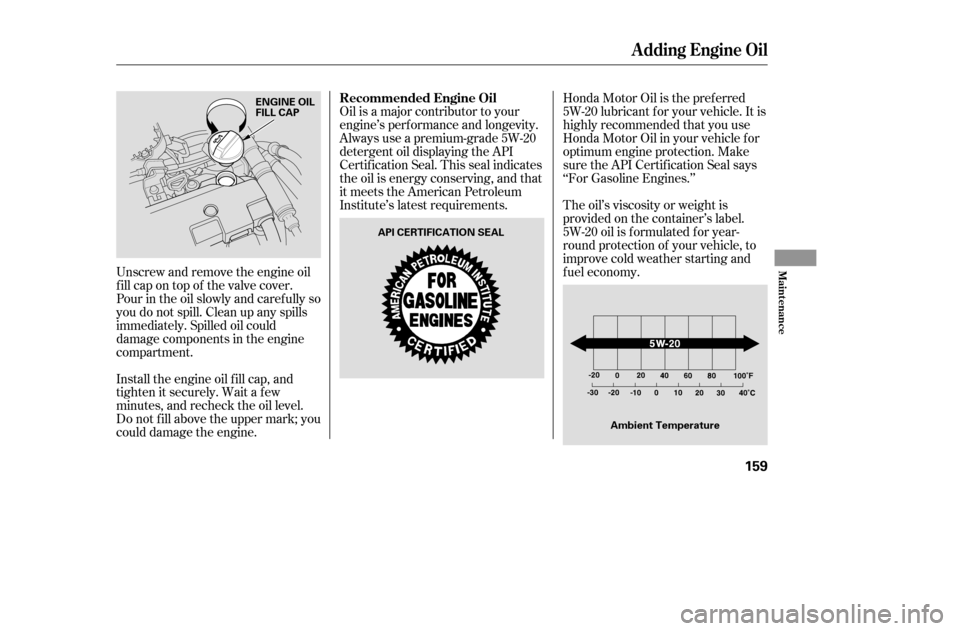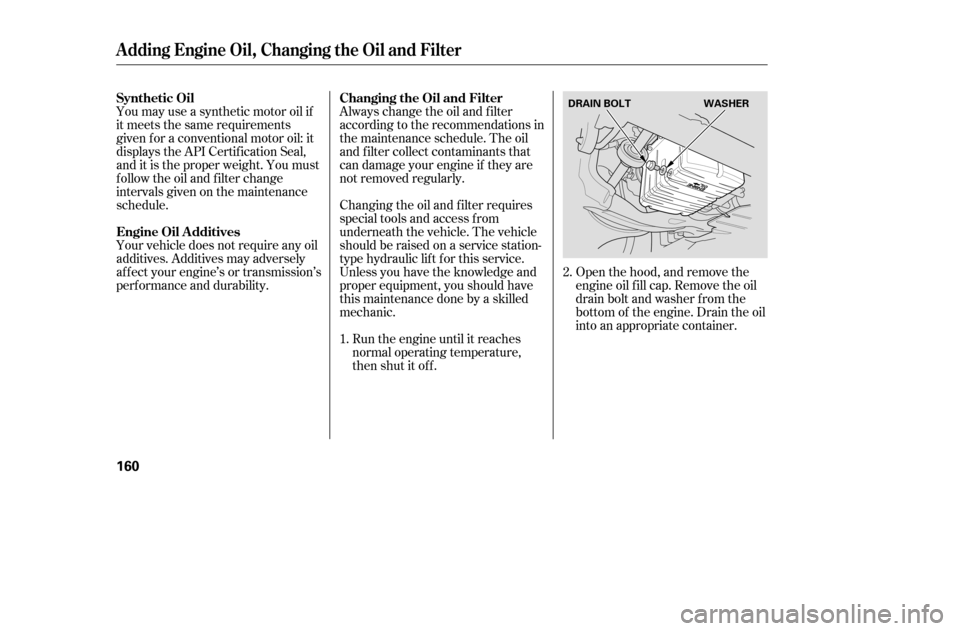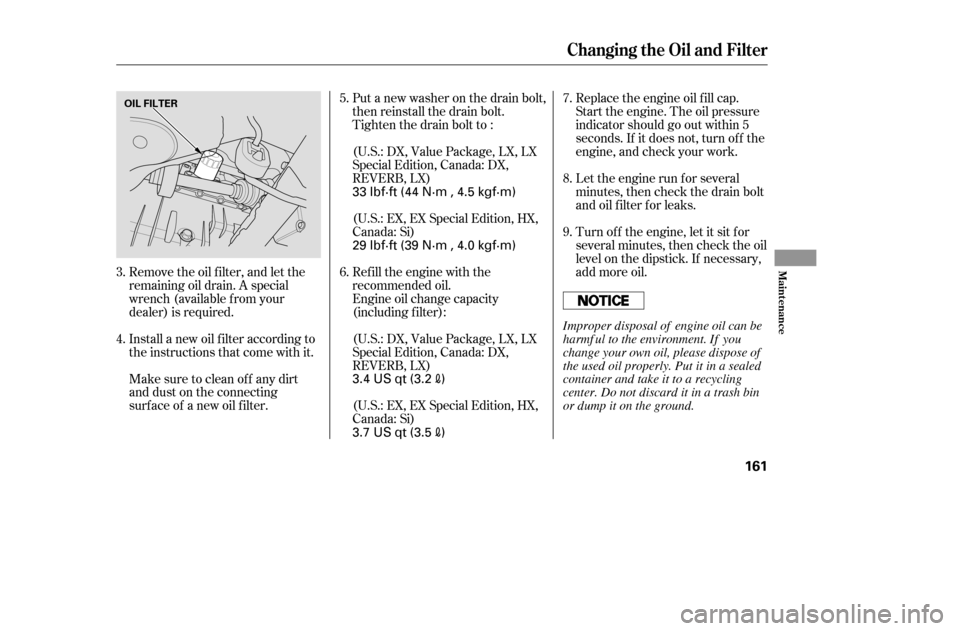Page 146 of 226

�Ì
�Î �Î�Î�Î �Ì�Ì
�Î
�Î
�Î �Ì�Î
154
Service the items listed at the indicated distance (or time, if given). miles x 1,000
km x 1,000 101620323048 40645080 70
112 80
128 130208
Check oil and coolant at each fuel stop
Check inflation and condition once a month
Every 5,000 miles (8,000 km) or every 6 months, whichever comes first Every 10,000 miles (16,000 km)
Every 10,000 miles (16,000 km) or every 1 year, whichever comes first
Every 20,000 miles (32,000 km) or every 1 year, whichever comes first
Every 30,000 miles (48,000 km) or every 2 years, whichever comes first
Every 15,000 miles (24,000 km) (Use normal schedule except in dusty conditions)
Inspect every 110,000 miles (176,000 km), otherwise adjust only if noisy
Every 3 years (independent of mileage)
At 120,000 miles (192,000 km) or 10 years, then every 60,000 miles (96,000 km) or 5 years Every 110,000 miles (176,000 km) or every 7 years, whichever comes first
See information on maintenance and emissions warranty, middle column, page .
See dust and pollen filter on page for replacement information under special driving conditions.
Replace at 60,000 miles (96,000 km) or 3 years, then every 30,000 miles (48,000 km) or 2 years.
Replace at 60,000 miles (96,000 km) or 3 years, then every 40,000 miles (64,000 km) or 2 years.
See timing belt on page for replacement information under special driving conditions. Every 60,000 miles (96,000 km) or every 3 years, whichever comes first90
144 120192 150240
110176 140224
100160
6096
Check engine oil and coolant
Check tires
Replace engine oil
Rotate tires (follow pattern on page 181 )
Replace engine oil filter
Check front and rear brakes
Lubricate all hinges, locks and latches
Inspect the following items: Tie-rod ends, steering gearbox, and boots
Suspension components, Driveshaft boots
Check parking brake adjustment
Inspect the following items: Brake hoses and lines (including ABS)
All fluid levels and condition of fluids
Exhaust system , Fuel lines and connections
Lights and controls/vehicle underbody
Inspect and adjust drive belts
Replace dust and pollen filter
Replace air cleaner element
Replace spark plugs
Inspect valve clearance
Replace automatic transmission fluid
Replace manual transmission fluid
Replace CVT fluid
Inspect idle speed
Replace timing belt , inspect auto-tensioner and water pump
Replace engine coolant
Replace brake fluid
:
1:2:3:4: 152
176
169 1
2
3
,4
Maintenance Schedule for Severe Conditions
�����—�����—�����y�
�����������
�y���
�(���%�������y���
�����y
Page 150 of 226
Fluid Locations
158
BRAKE FLUID
(Gray cap)WASHER FLUID
(Blue cap)
POWER STEERING
FLUID (Red cap)
AUTOMATIC
TRANSMISSION FLUID
DIPSTICK (CVT)
(Yellow loop)
RADIATOR CAP
ENGINE
COOLANT
RESERVOIR ENGINE OIL DIPSTICK
(Orange loop)
AUTOMATIC
TRANSMISSION
FLUID DIPSTICK
(except CVT)
(Yellow loop) CLUTCH FLUID
(Manual
transmission only)
(Gray cap)
ENGINE OIL
FILL CAP
�����—�����—�����y�
�������������y���
�(���%�������y���
���
�y
Page 151 of 226

Oil is a major contributor to your
engine’s perf ormance and longevity.
Always use a premium-grade 5W-20
detergent oil displaying the API
Certif ication Seal. This seal indicates
the oil is energy conserving, and that
it meets the American Petroleum
Institute’s latest requirements.Honda Motor Oil is the pref erred
5W-20 lubricant f or your vehicle. It is
highly recommended that you use
Honda Motor Oil in your vehicle f or
optimum engine protection. Make
sure the API Certif ication Seal says
‘‘For Gasoline Engines.’’
Unscrew and remove the engine oil
fill cap on top of the valve cover.
Pour in the oil slowly and caref ully so
you do not spill. Clean up any spills
immediately. Spilled oil could
damage components in the engine
compartment.
Install the engine oil f ill cap, and
tighten it securely. Wait a f ew
minutes, and recheck the oil level.
Do not f ill above the upper mark; you
could damage the engine. The oil’s viscosity or weight is
provided on the container’s label.
5W-20 oil is f ormulated f or year-
round protection of your vehicle, to
improve cold weather starting and
f uel economy.
Recommended Engine Oil
A dding Engine Oil
Maint enance
159
ENGINE OIL
FILL CAP
API CERTIFICATION SEAL
Ambient Temperature
�����—�����—�����y�
���������
���y���
�(���%�������y���
�����y
Page 152 of 226

Always change the oil and f ilter
according to the recommendations in
the maintenance schedule. The oil
and f ilter collect contaminants that
can damage your engine if they are
not removed regularly.
Changing the oil and f ilter requires
special tools and access f rom
underneath the vehicle. The vehicle
should be raised on a service station-
type hydraulic lif t f or this service.
Unless you have the knowledge and
proper equipment, you should have
this maintenance done by a skilled
mechanic.Run the engine until it reaches
normal operating temperature,
then shut it off. Open the hood, and remove the
engine oil f ill cap. Remove the oil
drain bolt and washer f rom the
bottom of the engine. Drain the oil
into an appropriate container.
You may use a synthetic motor oil if
it meets the same requirements
given f or a conventional motor oil: it
displays the API Certif ication Seal,
and it is the proper weight. You must
f ollow the oil and f ilter change
intervals given on the maintenance
schedule.
Your vehicle does not require any oil
additives. Additives may adversely
af f ect your engine’s or transmission’s
perf ormance and durability.
1.2.
Changing the Oil and Filter
Synthetic Oil
Engine Oil A dditives
A dding Engine Oil, Changing the Oil and Filter
160
DRAIN BOLT WASHER
�����—�����—�����y�
�������������y���
�(���%�������y���
�����y
Page 153 of 226

Replace the engine oil f ill cap.
Start the engine. The oil pressure
indicator should go out within 5
seconds. If it does not, turn of f the
engine, and check your work.
Turn of f the engine, let it sit f or
several minutes, then check the oil
level on the dipstick. If necessary,
add more oil.
Put a new washer on the drain bolt,
then reinstall the drain bolt.
Tighten the drain bolt to :
Let the engine run f or several
minutes, then check the drain bolt
and oil f ilter f or leaks.
Install a new oil f ilter according to
the instructions that come with it.
Remove the oil f ilter, and let the
remaining oil drain. A special
wrench (available from your
dealer) is required.
Make sure to clean of f any dirt
and dust on the connecting
surf ace of a new oil f ilter. Refill the engine with the
recommended oil.
Engine oil change capacity
(including f ilter):
5. 6.
7. 8. 9.
(U.S.: EX, EX Special Edition, HX,
Canada: Si)
3. 4. (U.S.: DX, Value Package, LX, LX
Special Edition, Canada: DX,
REVERB, LX)
(U.S.: EX, EX Special Edition, HX,
Canada: Si)
(U.S.: DX, Value Package, LX, LX
Special Edition, Canada: DX,
REVERB, LX)
Changing the Oil and Filter
Maint enance
161
OIL FILTER
33 lbf·ft (44 N·m , 4.5 kgf·m)
29 lbf·ft (39 N·m , 4.0 kgf·m)
3.7 US qt (3.5
)
3.4 US qt (3.2
)
Improper disposal of engine oil can be
harmf ul to the environment. If you
change your own oil, please dispose of
the used oil properly. Put it in a sealed
container and take it to a recycling
center. Do not discard it in a trash bin
or dump it on the ground.
�����—�����—�����y�
�������������y���
�(���%�������y���
�����y
Page 154 of 226

If the coolant level in the reserve
tank is at or below the MIN line, add
coolant to bring it up to the MAX line.
Inspect the cooling system f or leaks.Always use Honda All Season
Antif reeze/Coolant Type 2. This
coolant is pre-mixed with 50 percent
antif reeze and 50 percent water.
Never add straight antifreeze or
plain water.
If Honda antif reeze/coolant is not
available, you may use another
major-brand non-silicate coolant as a
temporaryreplacement.Makesureit
is a high-quality coolant
recommended f or aluminum engines.
Continued use of any non-Honda
coolant can result in corrosion,
causing the cooling system to
malf unction or f ail. Have the cooling
system f lushed and ref illed with
Honda antif reeze/coolant as soon as
possible.
If the reserve tank is completely
empty, you should also check the
coolant level in the radiator.
A dding Engine Coolant
Engine Coolant
162
RESERVE TANKRemoving the radiator cap
while the engine is hot can
cause the coolant to spray out,
seriously scalding you.
Always let the engine and
radiator cool down before
removing the radiator cap.
�����—�����—�����y�
�����������
�y���
�(���%�������y���
�����y
Page 155 of 226
When the radiator and engine are
cool, relieve any pressure in the
cooling system by turning the
radiator cap counterclockwise,
without pressing down.The coolant level should be up to
the base of the f iller neck. Add
coolant if it is low.
Pourthecoolantslowlyand
caref ully so you do not spill. Clean
up any spill immediately; it could
damage components in the engine
compartment.
Put the radiator cap back on and
tighten it.
Remove the radiator cap by
pushing down and turning
counterclockwise. Pour coolant into the reserve tank.
Fill it to half way between the MAX
and MIN marks. Put the cap back
on the reserve tank.
Do not add any rust inhibitors or
other additives to your vehicle’s
cooling system. They may not be
compatible with the coolant or
engine components.
1. 2. 3. 4.
5.
Engine Coolant
Maint enance
163
RADIATOR CAP RESERVE TANK
�����—�����—�����y�
�������������y���
�(���%�������y���
�����y
Page 156 of 226
Check the f luid level in the
windshield washer reservoir at least
monthly during normal use.When you ref ill the reservoir, clean
the edges of the windshield wiper
blades with windshield washer f luid
on a clean cloth. This will help to
condition the blade edges.
Fill the reservoir with a good-quality
windshield washer f luid. This
increases the cleaning capability and
prevents f reezing in cold weather.
The low washer
level indicator comes on when the
level is low (see page ).
Check the f luid level by removing
the cap and looking at the level
gauge. 56On Canadian models:
Windshield Washers
164
LEVEL GAUGE
Do not use engine antif reeze or a
vinegar/water solution in the
windshield washer reservoir. Antif reeze
can damage your vehicle’s paint, while
a vinegar/water solution can damage
the windshield washer pump. Use only
commercially-available windshield
washer f luid.
�����—�����—�����y�
�������������y���
�(���%�������y���
�����y